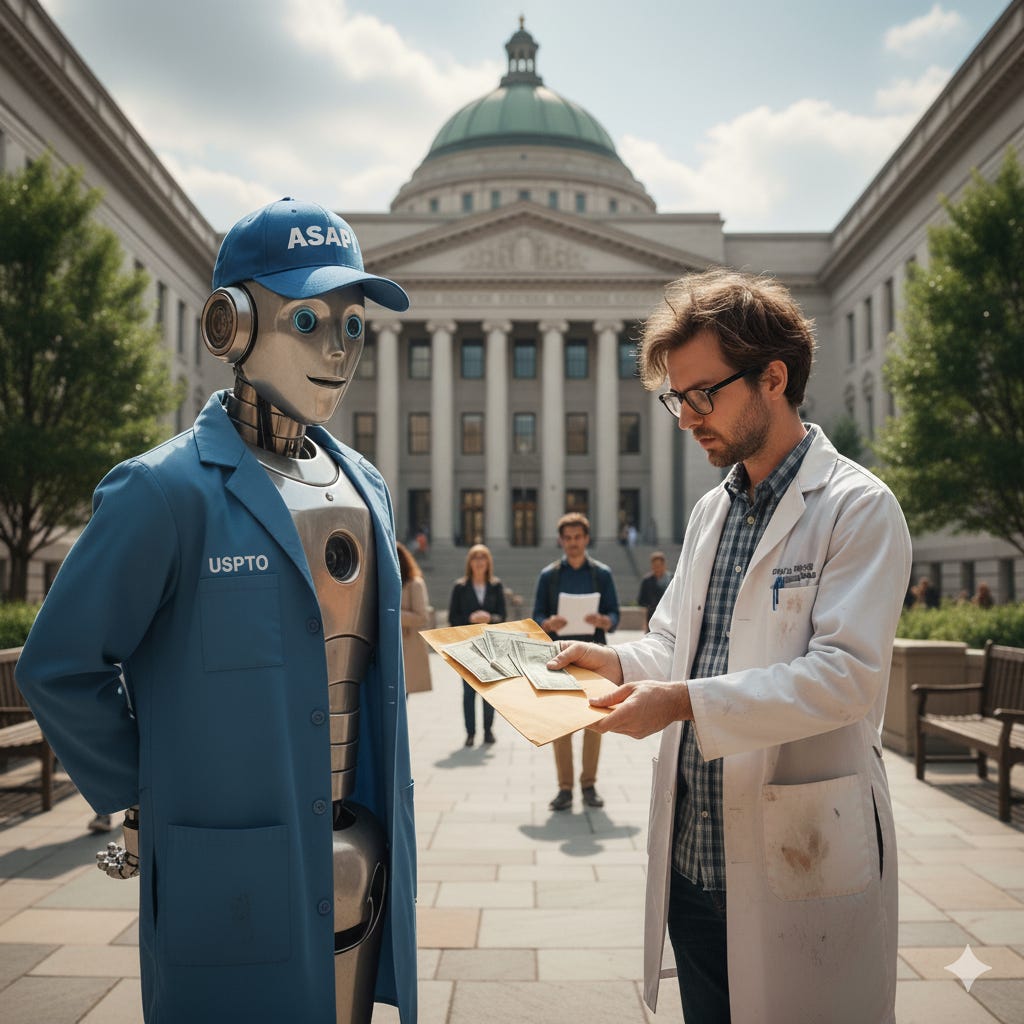USPTO Tests the Waters with New AI-Powered Search Pilot
ASAP! results for only $450 ($180 small entity)
The U.S. Patent and Trademark Office (USPTO) is officially leaning into artificial intelligence with the launch of its Artificial Intelligence Search Automated Pilot (ASAP!) Program. The new initiative, announced in a recent press release and detailed in the Federal Register, is designed to test the efficacy of the agency’s internal AI tools for conducting pre-examination prior art searches. Key questions will be (a) will the results be worthwhile and (b) will applicants want to pay the $450 petition fee ($180 small entity)?
Set to launch on October 20, 2025, the ASAP! program will provide participants with an AI-generated list of potential prior art before their application reaches an examiner.
This move is part of the USPTO’s “steadfast commitment to dramatically improve examination quality, response time, and efficiency.” In the announcement, USPTO Director John A. Squires framed the initiative as a fulfillment of his promise to “’lean-in’ to AI.” Director Squires added:
Our ASAP! announcement today is the first of many planned AI pilots designed to help examiners and applicants alike ensure their patents are born strong. Quality starts at filing... ASAP! is intended to foster common ground in the first instance. This is us leaning-in. Watch this space.
The agency hopes this will “provide the applicant with an earlier communication regarding potential prior art issues in their application” (Fed. Reg., p. 1).
The stated goals are to “ascertain the impact of sharing a pre-examination search report on prosecution by applicants, evaluate the scalability of generating ASRNs, and collect data to inform next steps” (p. 1).
For a limited number of applicants, this program offers a new way to assess an application’s prospects early in the process.
How the Program Operates
Participation requires applicants to opt-in by filing a petition on the same day they file their application.
To be eligible, an application must be an “original, noncontinuing, nonprovisional utility” filing in DOCX format via Patent Center (Fed. Reg., p. 1).
The process reportedly involves these key steps:
Petition: An applicant must file Form PTO/SB/470 and pay the petition fee set forth in 37 CFR § 1.17(f). The USPTO warns that an applicant “will not have an opportunity to correct deficiencies in the petition after a petition is dismissed” (p. 2).
Fees: The current fee is $450 for a large entity, $180 for a small entity, and $90 for a micro entity.
AI Search: The USPTO will use its internal AI tool to conduct a search based on the application’s classification, specification, claims, and abstract (p. 2).
The ASRN: The applicant receives an AI-Assisted Search Results Notice (ASRN), or what the press release calls a “’top ten list’ of potential prior art issues.” This notice is “not considered a notification under 35 U.S.C. 132, and the applicant is not required to respond” (p. 2).
The USPTO has taken steps to address potential AI bias by excluding applicant, inventor, and assignee information from the model’s training data and asserts that measures are in place to “maintain patent application confidentiality” (p. 2).
Benefits, Challenges, and Risks
This pilot program presents both opportunities and potential drawbacks that IP professionals should consider.
Potential Benefits
The most significant advantage is early intelligence. Receiving the ASRN affords applicants an “early opportunity to assess their claims against the prior art before substantive examination.”
The USPTO suggests this may inform several actions, including:
Refining Claims: Filing a preliminary amendment to place the “application in better condition for examination” (p. 1).
Preparing Evidence: Marshaling evidence for affidavit practice.
Managing Costs: Filing a “petition for express abandonment...to seek a refund of the search fee and any excess claims fees” if examination is no longer desired (p. 2).
Challenges and Risks
Despite the potential upsides, practitioners should approach the pilot with a degree of caution.
AI Reliability: The effectiveness of the program hinges on the quality of the AI’s output. The ASRN will list documents ranked by relevance “as determined by the AI tool” (p. 2). The actual relevance of these documents will not be seen until results are made public.
Confidentiality: While the USPTO assures data security, the use of AI with confidential application data will rightfully attract scrutiny from IP professionals.
Cost vs. Value: The petition requires a fee. Participants must weigh this cost against the uncertain value of the AI-generated report, especially when experienced searchers may yield more comprehensive results.
Strict Requirements: The eligibility criteria are narrow, and the process is unforgiving, as a “second or subsequent petition filed in the application will be dismissed” (p. 2).
Program Logistics and Duration
The ASAP! program is a temporary and limited initiative. It will accept petitions from October 20, 2025, until April 20, 2026, or when each utility-examining Technology Center has accepted 200 applications, whichever is first (p. 1). The agency plans to accept “at least 1,600 patent applications” in total (p. 1).
Looking Ahead
The ASAP! program is a significant and public step in the USPTO’s strategy to integrate AI into patent prosecution. It offers a select group of applicants a new tool to potentially streamline examination from the outset.
The USPTO’s success will be determined by the quality of the AI-generated results and the value that practitioners derive from them.
As Director Squires indicated, the IP community will be watching this space.
Disclaimer: This is provided for informational purposes only and does not constitute legal or financial advice. To the extent there are any opinions in this article, they are the author’s alone and do not represent the beliefs of his firm or clients. The strategies expressed are purely speculation based on publicly available information. The information expressed is subject to change at any time and should be checked for completeness, accuracy and current applicability. For advice, consult a suitably licensed attorney and/or patent professional.



